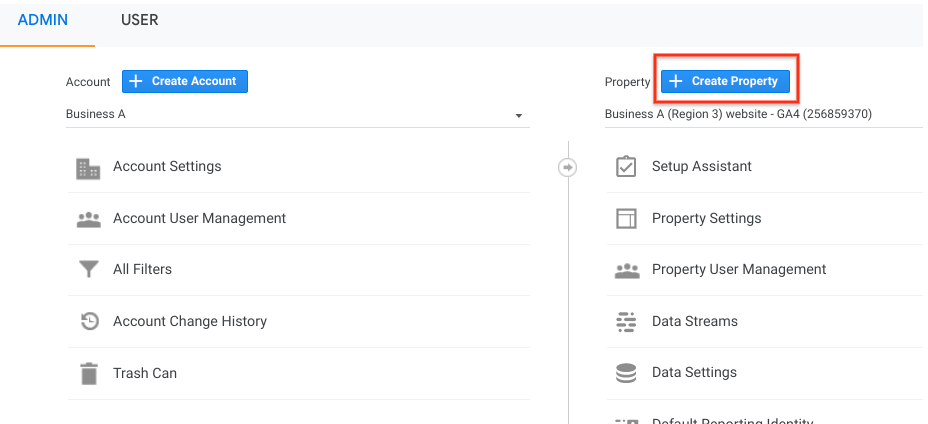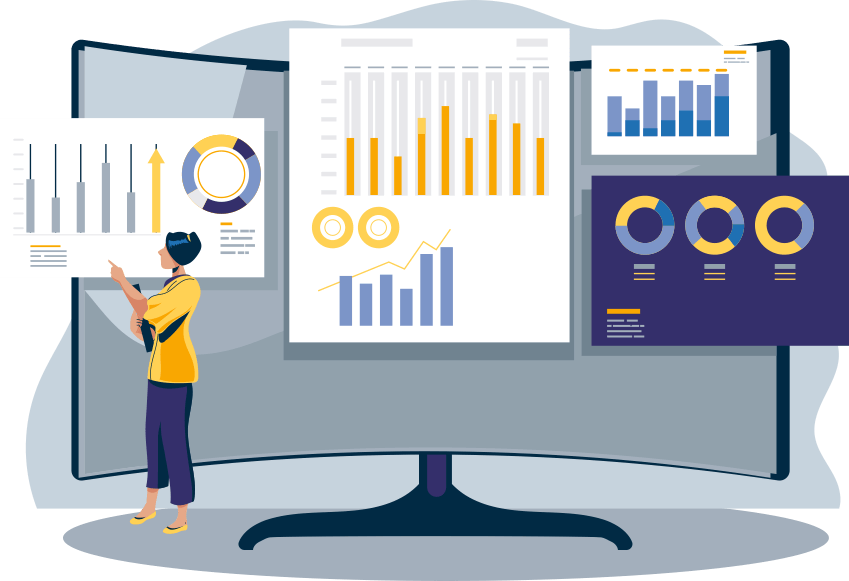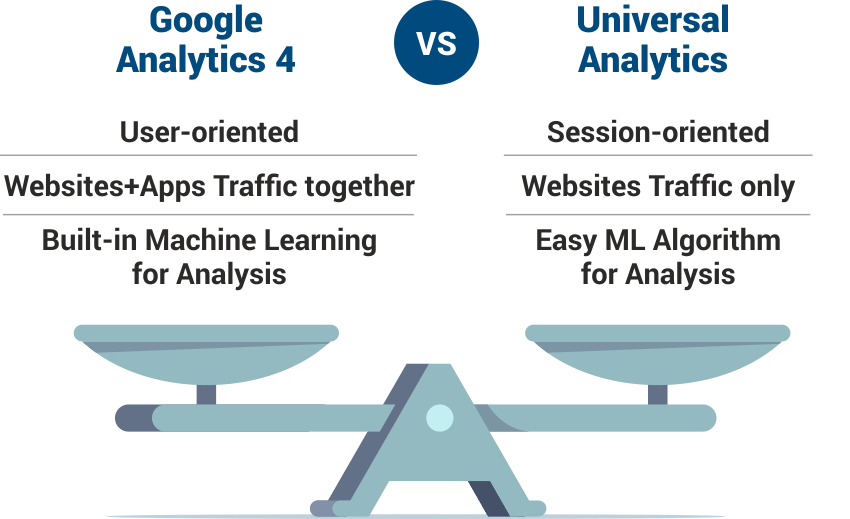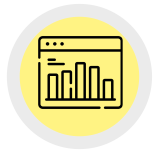What is, “Google Analytics 4 (GA4)”?
Google Analytics 4 is an advanced or upgraded version of Universal Analytics that replaces the latter with its notable feature of calculating the traffic and engagement across websites and apps.
As of now, Universal Analytics has been in use for a million users and businesses to track the interaction of its users across web domains, mobile apps, and offline application programming interfaces This has been used as a tool to track the amount of web traffic they get, track important marketing channels, and measure their main KPIs.
GA4 with its exceptional features, becomes capable enough to pause you, brighten the shine in your eyes, and at the end- make you love your job as a marketer.
It has some remarkable aspects that make it quite different from Universal Analytics which include its new data modeling feature that makes the use of AI to fill in gaps in data where traditional analytics get blocked usually by cookie-consent rules.
This latest generation of Google Analytics has a unique selling point that focuses on customer privacy. It carefully takes care of the latest privacy laws, such as GDPR and CCPA.
With its powerful features that include privacy-first tracking, cross-channel data measurement, and AI-driven predictive analytics, GA4 is for sure, a progressive property that many websites and apps will benefit from.
Hence, your shift to GA4 can drastically provide you with positive results. The benefits are as such :
How to set up Google Analytics 4 (GA4)?
The switch may seem overwhelming initially, however, it is worth spending your time on. With its advanced features, you may have an idea of how helpful it is.
It is important to start collecting data for future use as soon as possible.
Please keep in mind that Google Analytics 4 can only collect data from the date it is set up and activated. It cannot collect the previous data before the activation time.
Universal Analytics is likely to diminish in the future.

Thus, it would be great for your business to get used to the new property while you still have time.
The exciting mention is that you can have both the Universal Analytics property and a Google Analytics 4 property for your account. They will run simultaneously collecting data, so now you can begin accustoming yourself to the new property without letting your current reporting capabilities get out of hand.
If you do not have a google analytics account already, you would be required to create one. You would be landed on the new property by default, however, that is not a compulsion, and you are allowed to create the Universal analytics property too.
Here are some easy-to-understand steps to help you set up the property for your business:
- Log in to your Google account and visit https://analytics.google.com/analytics/.
- Click on “Start Measuring”
- Fill in the information with the name of your account (you might need to mention the name of your company if you are doing it for business), then tap on, “Next”
- Provide the property name and select the reporting time zone, and currency, and then tap on, “Next”

- To make a universal analytics property along with GA4, click on the "Show advanced options"

- Switch the toggle from off to on, and it will turn bright blue.
Next to it, you will be asked to provide the website URL, then select the option to create either universal analytics or both: select the option to GA4 and Universal Analytics Property. Click on “Next”, after selecting the appropriate option.
- Your next step is to provide details about your business by selecting the option relevant to your business, such as Industry Category, Business Size, and how do you intend to use Google analytics with your business?
- Post selecting all the relevant options to create GA4 and Universal Analytics Property under a new Google Analytics account, click on, “Create”.
- Then, check all the relevant boxes to accept the data processing terms as required by GDPR and the Measurement Controller–Controller Data Protection Terms of the data.
- Now click on, “I accept.”
Congrats. The process ends here, and you have successfully created the GA4 account.
However, in the other scenario,
When you have universal analytics and you want to shift to Google Analytics4, here is how you can do that.
The following steps will be understandable and helpful to you:
If you currently have a Universal Analytics property for your website, then the setup of a Google Analytics 4 property can be completed with the GA4 Setup Assistant.
- In Google Analytics, click “Admin” on the lower left of the screen.
- In the Account column, select the desired account:
- In the Property column, select the Universal Analytics property that currently collects data for your website:
- In the Property column, select GA4 Setup Assistant:
- Click “Get started” under “I want to create a new Google Analytics 4 property:”
- If your site uses the gtag.js tag, you can select “Enable data collection using your existing tags.”
- Click “Create Property.”
- If you are unable to “Enable data collection using your existing tags,” it is for one of three reasons:
- Your website builder/CMS does not yet support the gtag.js tag.
- You use Google Tag Manager.
- Your website is tagged with analytics.js.
- In all three cases, you will need to add them on your own.
For mobile application monitoring, you may have been using Firebase. Here is how you can upgrade to Google Analytics 4 from Firebase:
- Log in to the Firebase console.
- Go to Analytics > Dashboard on the left panel.
- Click “Begin upgrade” on the banner at the top of the page.
- Follow the on-screen instructions to complete the upgrade.
Once that is upgraded, you will be able to find app analytics in both the Firebase console and Google Analytics.
Is it possible to run both the analytics simultaneously on the same website?
Yes, this is the approach that we suggest everyone stay intact to.
Is it possible to set up content grouping in GA4?
Yes, that is possible! You can do that by virtue of Google Tag Manager. The steps are as follows: Go to your GA4 config tag, under Fields to Set, and put a row with Field Name' content group'.
For the value, create a regex table with dimension {{Page Path}} to establish a set of rules, like creating content grouping in the UI for Universal Analytics.
Preview and issue, and the data will become presentable under Content Grouping in your GA4 property.
Where can I find the bounce rate in GA4?
The bounce rate measurement is not present in GA4. However, it has an array of significant engagement metrics to understand user engagement. Use 'engagement rate' in lieu. Engaged sessions are defined as sessions with a minimum of two pages, ten seconds on-site, or a conversion event the opposite of a bounce.
How to find the exit pages and exit % in GA4?
You will be able find the “exits” metric in the explorer section, but not the exit page metrics as that is not present in the regular reports in GA4.
You will also be required to create a fresh free-form exploration, use Page Path, and Exits as the dimension and metric respectively!
However, the drawback is that you cannot calculate an exit rate percentage within the GA4 interface. It is suggested that you head over to the data studio to do this.
Can I export data from GA4?
Yes, it is possible.
Can I connect google optimize to GA4?
No, you cannot do that as of now. This is because there is no connector available for Google to optimize and GA4. However, the good news is that you will be able to do that soon because its implementation is on the way
How can I view traffic by channel in GA4?
To view the traffic by channel in GA4, please follow the below-mentioned steps:
Head towards- Reports > Acquisition > Traffic acquisition and replace the little drop-down from the primary dimension to 'Session default channel grouping'.
You will be able to see the description of each channel in Google's official documentation, but there is no allowance to edit the same.
Google Analytics 4 is creating a vast future: Conclusion
The conclusion in short is that GA4 is here to stay and is creating a vast future for businesses.
Despite the world still being unaware of GA4, its functionality, operation, new capabilities, and its expansion, one thing we know for sure is that GA4 has the potential to be our future and it is.
We need not put off the transition but embark on the migration path as soon as possible.
With the digital world changing persistently, it is a need for marketing specialists to be able to create reports on their own, polish up decision-making, examine all composed data in different slices and receive valuable insights.
GA4 is that analytics upgrade that all marketers need.
As mentioned earlier, it helps clients comprehend how users interact in a unified way, respects privacy and is built to address the needs of a cookie's future, addresses modern-day marketing needs, and last but not the least, it provides marketers with more flexibility.












